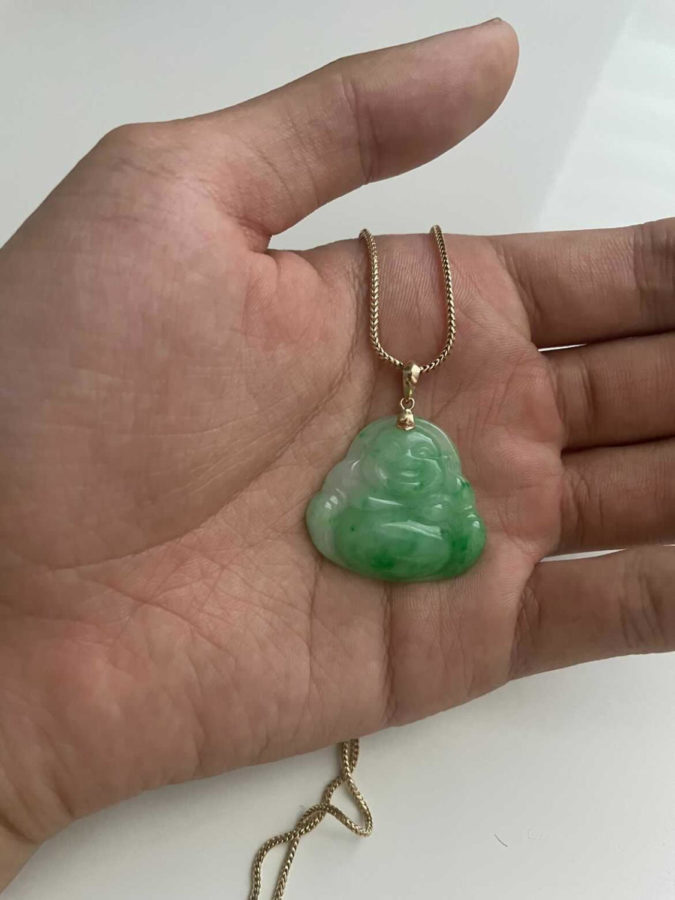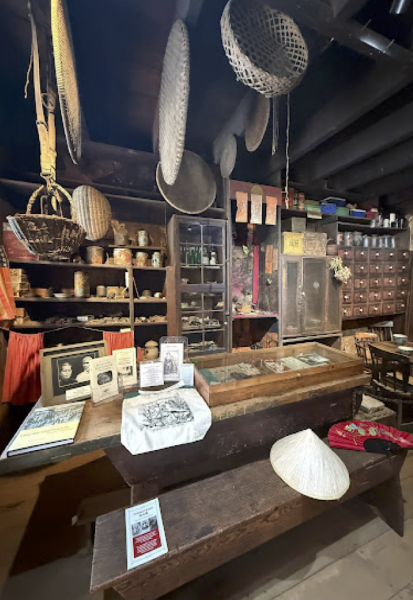Religiously and culturally trendy
Khoa Nguyen’s beautiful jade laughing Buddha necklace.
People love expressing themselves with their style, especially when they accent their outfits with jewelry. However, some people are taking their style to an extent where they are wearing jewelry belonging to a religious or cultural group that they are not a part of.
Various religions and cultures represent themselves through their unique pieces of jewelry.
Catholics are often seen wearing a cross, or crucifix, while Buddhists or southeast Asians are seen wearing jade pendants.
“I have a jade Buddha…It’s a laughing Buddha,” said junior Khoa Nguyen.
Nguyen is southeast Asian, specifically Vietnamese. Nguyen wears this pendant as a symbol of his culture.
“I feel like it’s like a good luck charm in a way,” said Nguyen.
According to Nguyen, he once lost his pendant in a parking lot in an area where cars would more than likely run it over. Although, when Nguyen got his pendant back, it did not have a single scratch on it.
“It was unscathed. That was pretty nice. It was cool,” said Nguyen.
Another student who proudly wears their jewelry around campus expressing their religion is freshman Joseph Cattolico.
“I wear a cross on my neck that’s attached to a chain. I wear it because I’m Catholic,” said Cattolico.
Cattolico received his necklace as a gift from his grandparents after receiving his confirmation.
“(Confirmation is) a sacrament in the Catholic Church, where you basically just acknowledge that God is good and Satan is bad,” said Cattolico.
Both Nguyen and Cattolico were aware of the trend going around of people wearing jewelry representing a religion or culture that is not theirs.
“I can’t really tell other people what to do. I wear the cross because I believe in God. Some people might not believe in God, they might think it looks cool, but I can’t really tell people what to do,” said Cattolico.
Nguyen had a similar response to Cattolico about this situation.
“It’s not bad…I feel like if you wear it, you should at least know about it. I just think you have to understand the cultural significance,” said Nguyen.
However, students such as seniors Jashan Singh and Heba Zulfiqar had opposite opinions where they saw this as a negative thing for the people’s culture and religion.
Singh explained that since she is Punjabi she does wear a lot of Punjabi jewelry such as jhumkas and tikkas which are commonly seen Indian earrings.
Since Singh does wear her cultural jewelry as a connection and representation to her culture, she had very strong feelings about the styling of them along with experiences.
“I kind of feel like it’s cultural appropriation because these used to be like religious and cultural things that we would wear… I remember me and a lot of Indian friends growing up had to stay away from these things because it was considered different,” said Singh.
Zulfiqar stated that she wears cultural earrings along with a necklace that has her name written in Arabic.
“It does make me feel confident especially because my friends group is also very cultural… We have similar cultures. So whenever I wear something that has a similarity, it makes me feel part of their group more or just you know, in touch with my culture,” said Heba.
Zulfiqar had strong feelings about the idea that people are styling their outfits with cultural jewelry without being aware of the culture.
“I’m kind of just annoyed in a way because they don’t really know why we wear the jewelry or anything, they just wear it because it’s pretty… We (referring to being Pakistani) are seen as people who are really smart or not as particularly pretty as other people. And then when they use our quote-on-quote ‘pretty jewelry’ or ‘pretty clothing’ or something, they just take it for themselves. I feel like that can be pretty hurtful. Not only to me, but to other people in that culture,” said Zulfiqar.
Freshman Scarlett McIntyre claimed that she wears a cross despite the fact that she is not religious at all, she just thinks it’s pretty.
“If they’re not dissing their culture or their religion I don’t think they would be offended by it… It’s their own choice to wear what they want,” said McIntyre.
David Tastor, who is a World Religions teacher at GBHS, acknowledges that before wearing a cultural or religious piece of jewelry, people should learn and gain an understanding of it along with the significance of it to the culture.
“I would encourage people to educate themselves as to what it is that they’re wearing. Then decide if it is something that does represent something that they believe in, and that they can understand both its religious, cultural and historical significance,” said Tastor.
Mahalina is a freshman and this is her first year on the Gazette staff.









